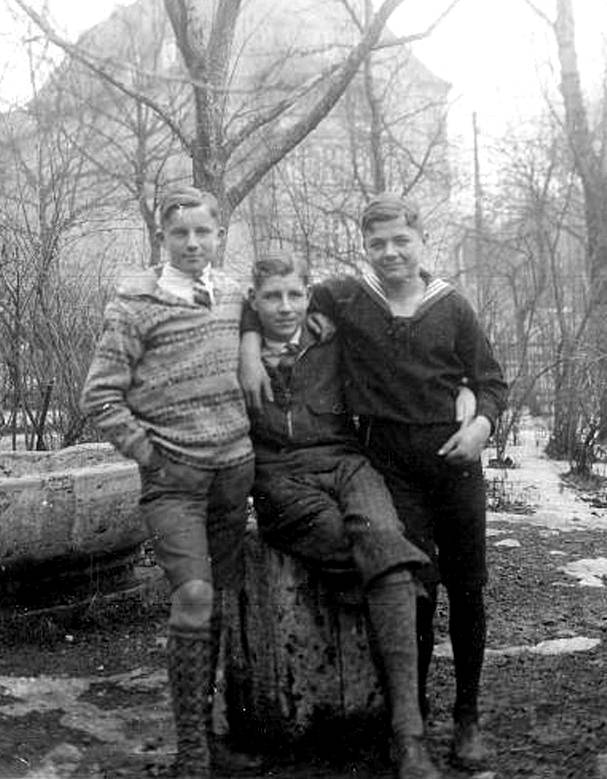
German Boys' Pants: Age Conventions--Chronological Years

Figure 1.-- A trio of German boys enjoying each other's company on a rather bleak looking afternoon. en. I suspect these boys came from affluent families. The ties are a clue ghere. The boys were photographed on the property of one of them. We suspect all three were still in school as boys from affluent families generally attended secondary school. There is quite an impressive building in the bsckground. The neighborhood seems to be residential. The clothes are somewhat varied. One boy wears a traditional dark sailor suit with longish short trousers or knee pants with black long stockings. Another wears a sporty knicker suit with knickers that fasten below the knee and plain knee socks. The third boy wears a collared sweater open at the neck with a shirt and tie, short trousers, and diamond patterned knee socks. We suspect these were typical school clothes for the boys, who look as though they are about 13-14 years old.
|
|
The pants worn by German boys at each chronological age level is a little complicated because the conventions as well as the popularity of different types of pants changed substantially over time. While our information is limited on the early 19th-century, we have a fairly good idea from the mid-19th century on as to what type of pants German boys of different ages wore. Boys mostly wpre long pants in the 19th century, although we see boys at mid-century wearing various kinds of shortrned -length pants. These pants began to become more populasr in the late-19th century. After the turn-of-the-20th century we begin to see more older boys wearing them. This is especially true during the 1910s. During the inter-war era, most boys wore short psnts, including tounger teenagers. Some teenagers wore knickets. This trend continued after the War. We note more boys wearing long pants in the 1960s, even younger boys. And by the 1970s short pabnts were primarily warm weatgher, casual wear for pre-teens. Older boys wanted to wear jeans and were much less likely to dress up. This was the beginning of a kind of generalized European fashiomn. It becomes much more difficult to identify individual countries grom the clothes people are wearing. We have a fairly extensive archive of German images to document these and iother trends. And our archive is constantly expanding.The major complication here is that most of the images do not note the age of the children pictured. Thus we have had to estimate ages. This means we might be off by a year or so and this should be kept in mind when reviwing ths section. We welcome reader cimment if they have any comments on our age assessments. While we may be off a year or so in the estimates, this will not materially affect the basic assessment.
Age 13 years
Most 13 year-old German boys wore long pants in the 19th century. Some may have worn knee pants or bloomer knickers in the 1890s, but mostly we see boys this age wearing shortened-length pants after the turn-of-the 20th century. At this age most boys were still in school. Shortened length pants become increasinglu common in the 1900s and especially by the 1910s. In the inter-War period most younger vteen agers wore short pants, even during the winter. The boys here in the 1930s are a good example, they look to be about 13-14 years old (figure 1).
Age 14 Years
We believe most 14-year olds in the 19th century wore long pants. A few boys may have worn knee pants or bloomer knickers in the 1890s, but mostly we see 14-year olds wearing shortened-length psnts after the turn-of-the 20th century. Boys of this age from working-class families would have finished school. Many would have begin apprecticeships. Secondary education for all children did not become coomon for all children until after World War II. Many 14-year olds wore short pants during the inter-War era. Some younger teen-agers may have worn knickers, especially during the winter. Tghe boy here is an good example (figure 1).
Age 15 Years
Most 15-year olds wore long pants in the 19th century. This begun to change after the turn-of-the century as we begin to see older boys wearing shortened-length pants. This seems fairly common in the 1910s. During the inter0War period many 15-year olds wore shorrt pants. This varied from family to family. This was the age that many boys began wearing long pants. This was particularly true of the boys who nhad left school. But even some of the boys in school began wreating long pants. Some prents thought tghis was about the right age to begin wearing long pants. More conservative parents might insist on short pants a little longer. Often parents bought a long pnts suit for boys about age 15 uears, but the boy continued to wear shorts except when dressing up in the suit. Another ioption was knickers and we see some boys wearing knickers in their teen years.
HBC

Navigate the Boys' Historical Clothing German pages:
[Return to the Main German pants chronology page]
[Return to the Main German pants page]
[German choirs]
[German scouts]
[German youth groups]
[German school uniforms]
[German sailor suits]
[Lederhosen]
[Ethnic]
[Tights]
[Long stockings]
Navigate the Boys' Historical Clothing Web Site:
[Introduction]
[Activities]
[Biographies]
[Chronology]
[Clothing styles]
[Countries]
[Bibliographies]
[Contributions]
[Essays]
[FAQs]
[Glossaries]
[Images]
[Links]
[Registration]
[Tools]
[Boys' Clothing Home]
Created: 6:44 PM 6/6/2009
Last updated: 6:44 PM 6/6/2009



